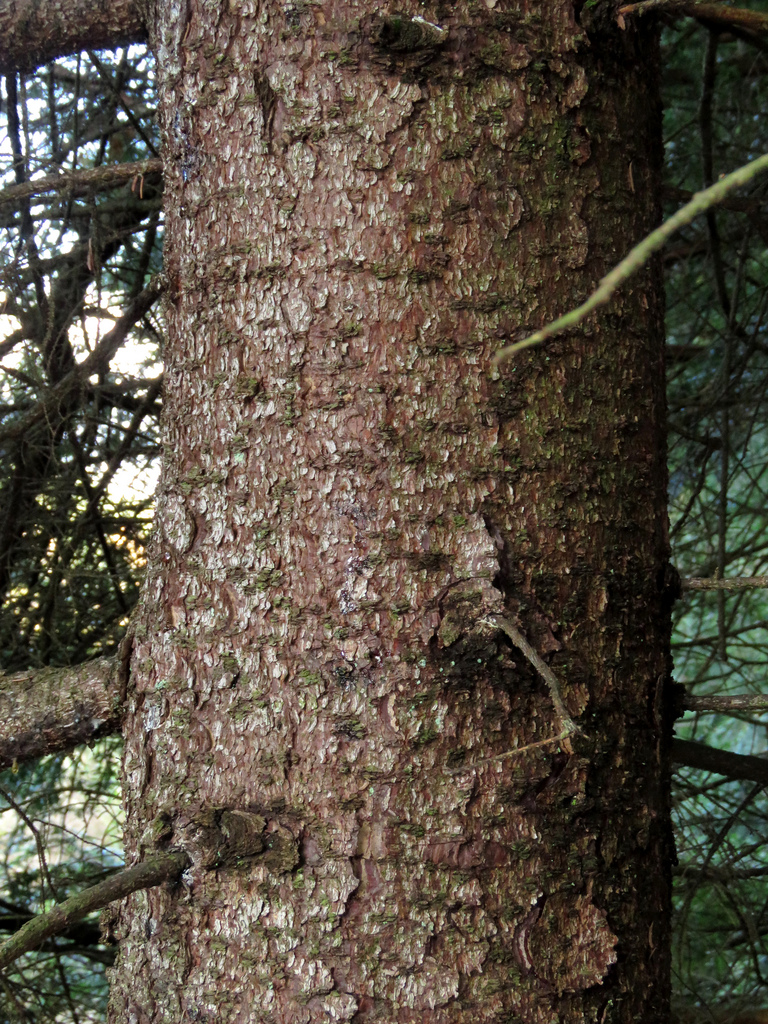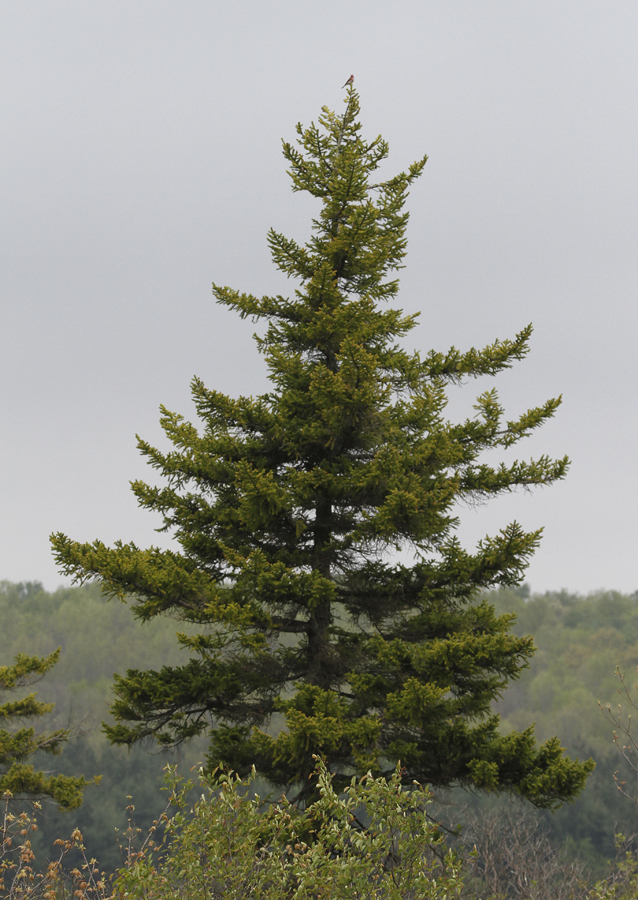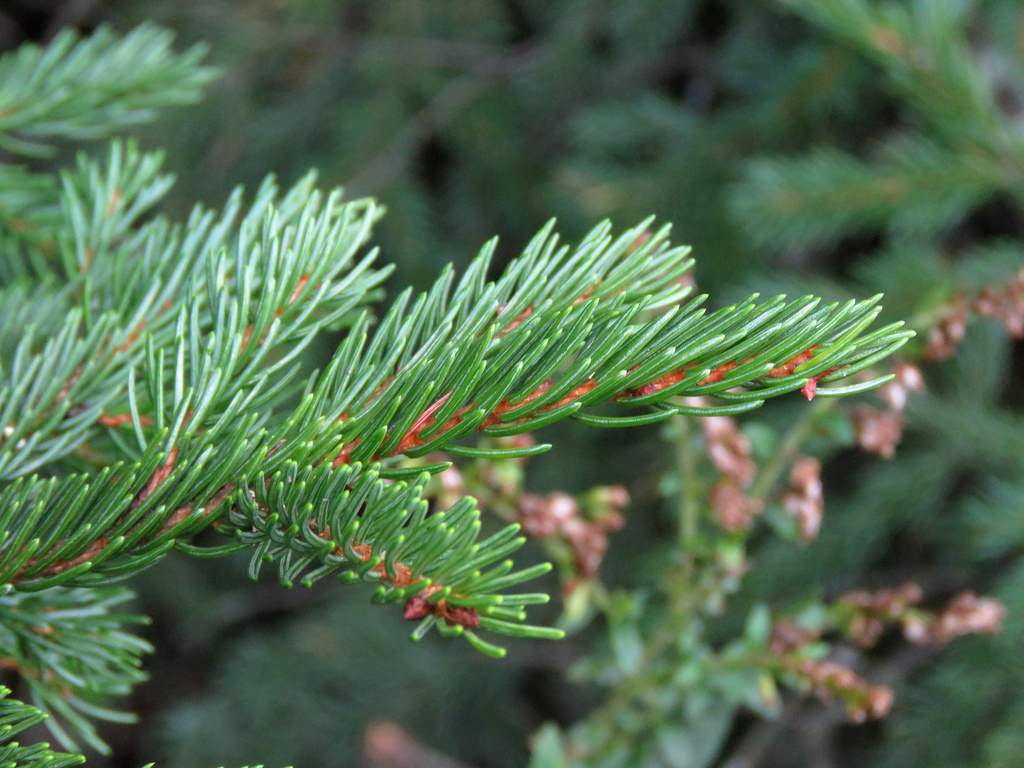Red Spruce
Picea rubens Sarg.
Description
Red spruce is in the pine family (Panaceae) and is the only spruce naturally occurring in Maryland ². It typically grows to 75 feet in the northern portions of its range, but may reach 110 feet in the Appalachian Mountains ¹. The bark is grayish to reddish-brown and is less than one-half inch thick. The needles are borne singly on small pegs along the branch ². Each needle is one-half to five-eights inch long and is four-sided or square in cross section ³. The needles are yellow-green and sharp pointed. Male and female cones are produced on the same tree. The female cones mature at the end of the second summer and are 1.5 inches long ¹. The cone scales lack prickles.

Trunk of red spruce. J. Emm, Maryland Biodiversity Project ²

Aspect of red spruce in Maryland. B. Hubick, Maryland Biodiversity Project ²

Needles of red spruce. J. Emm, Maryland Biodiversity Project ²
Cones of red spruce. K. Kanoti ³
Distribution
Red spruce can be found from the Canadian provinces of Nova Scotia and Southern Quebec to Eastern Ontario. It is found throughout Maine, Vermont and New Hampshire and in Eastern New York. Scattered populations occur along the Appalachian Mountain peaks to North Carolina ¹. It is located solely in far western Maryland in Garrett and Allegheny Counties ². It’s range is characterized by cold winters with an average of 100 to 140 days of snow cover and 0 to 8 F minimum temperatures and by cool summers with maximum temperatures below 80 F ¹.

Native range of red spruce. Wikimedia Commons 4
Wildlife Importance
Spruce forests provide habitats for numerous birds and mammals ¹. White-winged Crossbills and Spruce Grouse rely on red spruce for food. Small mammals such as American Red Squirrels and voles rely on its seed. The habitat created by spruce forests are used by numerous animals including White-tailed Deer, American Marten, Snowshoe Hare, and Canada Lynx for winter habitat 7.
Economic Importance
Because of the wood has high elasticity and uniform texture, red spruce is widely used for construction of musical instruments such as violins, guitars and piano sounding boards ³.
Threats
Red spruce populations in the central Appalachian Mountains have been reduced by 90% due to logging ². It is also susceptible to air pollution ³. It is intolerant of fire ¹. Spruce budworm, Choristoneura fumiferana, is the most important damaging insect ¹. Other harmful insects include the spruce budworm and sawfly larva ¹.
Interesting Facts
- An exudate from the trunks, spruce gum, was the basis for the chewing gum industry in the latter half of the 19th century and the early 20th century ¹.
- Humans may develop a rash from the sawdust of red spruce ³.
- The National Champion red spruce is in Giles County, Virginia with a height of 115 feet and a diameter of 52.5 inches as last measured in 2013 5.
- A red spruce was the National Christmas Tree for 2022. It was a 78-foot tree selected from North Carolina 6.
References
- USDA Forest Service Silvics, Vol. 1–Gymnosperms: Picea rubens
- Maryland Biodiversity Project: Picea rubens
- North Carolina State Extension: Picea rubens
- Wikimedia Commons: Picea rubens
- American Forests: Picea rubens
- USDA Forest Service: Introducing Ruby the Red Spruce:…
- New England Forestry Foundation: Meet the red spruce
Contributed by J. Hull

